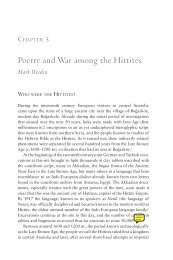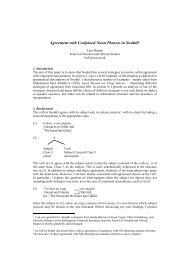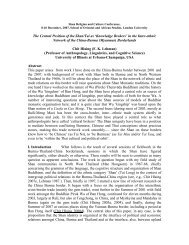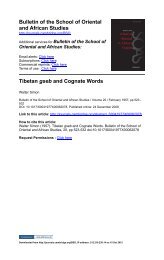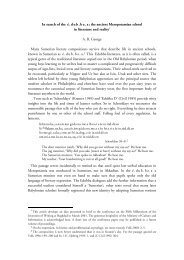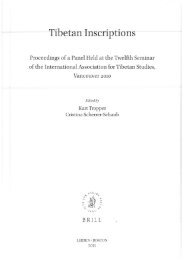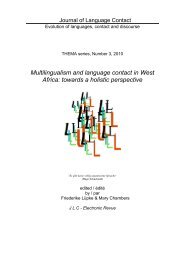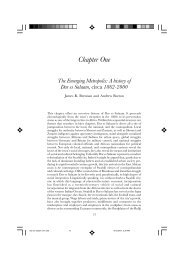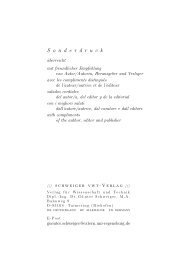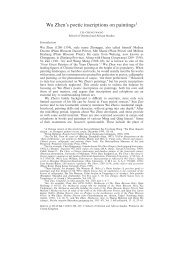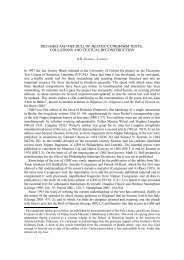Literarische Stoffe - The School of Oriental and African Studies
Literarische Stoffe - The School of Oriental and African Studies
Literarische Stoffe - The School of Oriental and African Studies
You also want an ePaper? Increase the reach of your titles
YUMPU automatically turns print PDFs into web optimized ePapers that Google loves.
100<br />
Almut Hintze<br />
maiÑiiÚi.zarçmaiia- ‘having spring at its centre’ in mid-spring,<br />
maiÑiiÚi.šçma- ‘having summer at its centre’ at the summer solstice,<br />
<strong>and</strong> maiÑii¡iriia- ‘mid-year’ at the winter-solstice.<br />
<strong>The</strong>se names indicate that the feasts were timed according to the position <strong>of</strong> the sun.<br />
Moreover, two further feast names derive, respectively, from seasonal agricultural <strong>and</strong> pastoral<br />
customs:<br />
paitiš.hahiia- is celebrated at the mid-year ‘corn-bearing’ time on day 180 (as counted<br />
from the spring equinox) <strong>and</strong><br />
aii¡þrima- fraouruua štrima- varšniharšta- ‘home-coming characterized by the return (<strong>of</strong><br />
cattle <strong>and</strong>) the release <strong>of</strong> rams’ at the end <strong>of</strong> summer on day 210 when cattle are driven<br />
home from the summer pastures <strong>and</strong> rams allowed access to the sheep.<br />
As we shall see, the name <strong>of</strong> the sixth festival, hamaspaþma daiia-, also describes the sun’s<br />
position. Thus, in view <strong>of</strong> the transparency <strong>of</strong> all these forms, Avestan speakers are likely to<br />
have understood their meaning, so that it is inconceivable, for instance, that they would have<br />
celebrated the mid-summer festival in winter. As Willi Hartner has put it, the festivals mark<br />
“six well-deŸned solar dates forming the solar “skeleton” <strong>of</strong> the year”. 4 This implies that the<br />
Avestan people had a Ÿxed calendar <strong>and</strong> managed to keep their feast times in permanent<br />
correspondence with the solar year. But the question is, how?<br />
In this article I propose to review the Avestan evidence for the Old Iranian calendar. First<br />
we shall look at the structure <strong>of</strong> a month <strong>and</strong> then at that <strong>of</strong> a year, <strong>and</strong> I shall put forward a<br />
new explanation for the much debated name hamaspaþma daiia-. After looking at the Fravashi<br />
festival celebrated at the time, I shall conclude that the Avestan people turned a 355-day lunar<br />
year into a 365-day solar one by means <strong>of</strong> the ten days <strong>of</strong> the hamaspaþma daiia-festival, while<br />
periodically inserting an additional day into one <strong>of</strong> the Ÿve 29-day winter months.<br />
2. Structure <strong>of</strong> the Avestan month<br />
Human experience <strong>of</strong> the rhythm <strong>of</strong> day <strong>and</strong> night together with the phases <strong>of</strong> the moon are<br />
the most fundamental ones lending themselves to the measurement <strong>of</strong> time. 5 This was also true<br />
for the Avestan people, who according to the stages <strong>of</strong> the waxing <strong>and</strong> waning moon between<br />
4 Hartner 1985, 750. On pp. 749–756 he further suggests that the seasonal holidays were Ÿxed on the basis<br />
<strong>of</strong> observations made at Persepolis on the rising <strong>and</strong> setting <strong>of</strong> different stars in the late 6 th century, cf.<br />
Panaino 1990, 662.<br />
5 Hartner 1985, 714.



